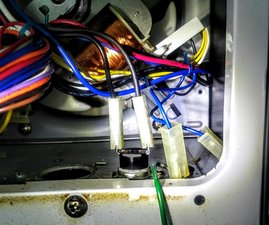GE XL1800, need help identifying Thermostat fuse and if it is the iss
Hi, GE XL1800 doesn't power on. Did continuity test for all fuses.
The schematic diagram, provided when pulling off the user touch pad, might as well be in an alien language because it doesn't help a novice like myself.
After researching possible causes of complete power outage, I ascertained (which makes sense) that it was likely a fuse issue. I started by conducting continuity tests of the traditional tubular fuses (both checked out fine) I then tested the two immediately accessible thermostat fuses. On is on the floor, in the component cavity behind the circuit board, when removing the microwaves touch pad control panel and one is located on the "back wall" that is parallel to the circuit board.
The fuse on the floor had continuity but the "back wall" fuse had no continuity. Aha, I thought, this is the problem child. Then after researching I was informed that there are thermo fuses that are closed, non continuous. The only identifier on this fuse was KSD-40LC & AC 250v/10A - AC125v/15A
So, color me lost. I found a couple of responses to no power and searched countless youtube videos. No one confirms why one thermostat fuse would be closed and that I should look at the diagram behind the touch pad, which I have done.
They are called TCO One is cavity, magnetron, hood, bottom. The drawings do not offer any physical representation that I can decipher. I have also looked into repair manuals ut they are only downloadable with subscriptions. Repairs are fortunately infrequent for me.
So, might a kind soul be able to advise why a thermo fuse might remain closed, intentionally? If this fuse sounds like it fits the "closed" bill? If so, could it be the problem? and if so, might anyone be able to help me narrow it down to a specific type so that I can order the correct part?
Honestly, these fuses aren't expensive so it isn't about the money so much as it is about trying my best to narrow it down so that time isn't wasted. My wife can't live without it. =) Thank you all for reading and for your very kind assistance.






crwdns2934109:0crwdne2934109:0

 2
2 
 928
928  2.4crwdns2936485:0crwdne2936485:0
2.4crwdns2936485:0crwdne2936485:0
crwdns2944067:03crwdne2944067:0
@frenchmanfl post some images of the schematic you have as well of the MW as far as you have taken it apart. It will help if we can see the boards etc and compare that to the schematics. Remember that MW have extremely high voltages and getting zapped by one of those could be a heart stopping experience. Use this guide Adding images to an existing question to add images.
crwdns2934271:0crwdnd2934271:0 oldturkey03 crwdne2934271:0
Hi Old Turkey, first, thank you very much for taking the time to respond.
Yes, I have read about the lingering charge, even after the microwave is unplugged. Got lucky. Hopefully that charge dissipates after 24 hours unplugged.
As per your very kind request, I have attached some pics that will hopefully offer some insight. I omitted the wiring diagram as it likely would not help (I could be wrong) The close up image of the belly of the beast shows the Therm fuse on the "floor" and there is an area just behind it near the bottom right corner on the "back wall" showing the space where the other Therm fuse lives (currently uninstalled). This one is also pictured and unlike the other, this has some blue paint (color coding?).
As per my previous post, the one on the floor has continuity and the uninstalled and pictured one does not. It is for this reason that I pulled it out. However, as also mentioned, I read that thermo fuses (depending on their function) do not all function with continuity.
crwdns2934271:0crwdnd2934271:0 Patrick crwdne2934271:0
This is all very confusing, to say the least. Not being an electrical engineer I am unable to reason my way out of this one. =) I am hoping that the blue paint offers the strongest clue as to whether this is the culprit or not. As mentioned, previously, I tested the tubular fuses and both tested with continuity. The only other possible culprit could be the magnetron but to get to that I need to get the MW off the wall etc.
I am crossing my fingers and toes that the images offer some insight.
Once again, thank you very much for taking time out of your day to respond and assist. I am very grateful.
I look forward to receiving your diagnosis. =)
crwdns2934271:0crwdnd2934271:0 Patrick crwdne2934271:0